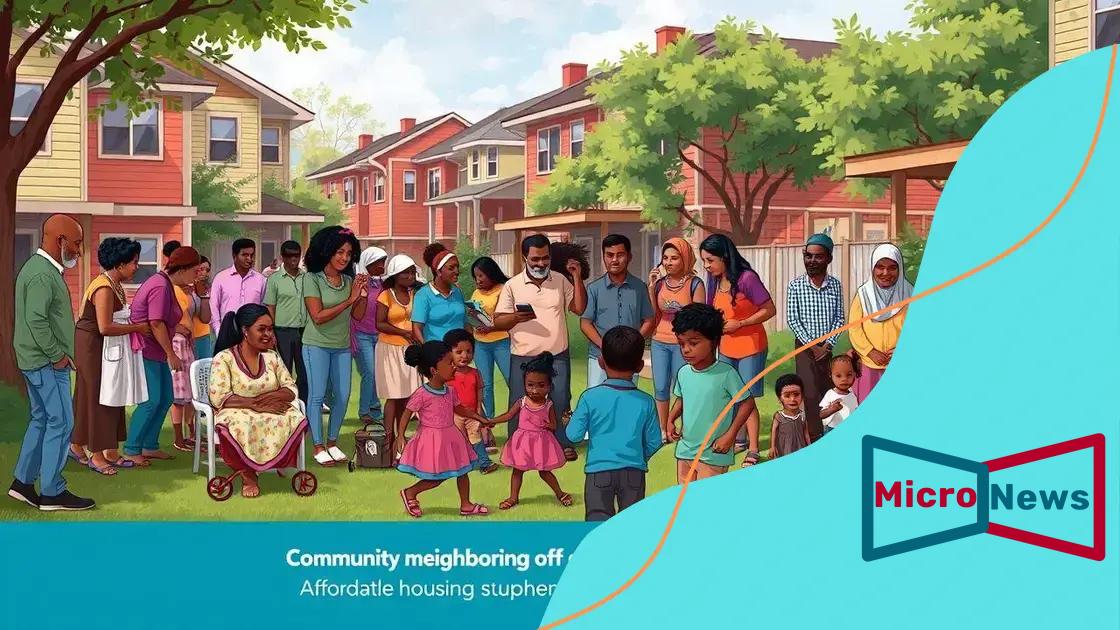Affordable housing initiatives for low-income families

Affordable housing initiatives for low-income families provide essential support by ensuring access to safe, affordable homes, improving community stability, enhancing health outcomes, and fostering economic growth.
Affordable housing initiatives for low-income families play a crucial role in providing stability and security. Have you ever wondered how these programs can truly change lives? Let’s explore their impact and benefits.
Understanding affordable housing
To truly grasp the essence of affordable housing, we must first understand what it entails. Affordable housing refers to housing units that are financially accessible to low-income families. It plays a vital role in communities by ensuring everyone has a place to live without sacrificing basic needs.
The Fundamentals of Affordable Housing
Affordable housing is not just a roof over one’s head; it’s a cornerstone of a thriving community. When families have access to affordable homes, they can focus on education, health, and employment. The standards for what constitutes “affordable” typically consider household income in relation to housing costs.
Key Aspects to Consider
Several factors contribute to the effectiveness of affordable housing programs. These include:
- Location: Proximity to schools, jobs, and healthcare services
- Quality: Safe and well-maintained living conditions
- Support Services: Access to resources like job training and childcare
Moreover, innovations in design and sustainability can enhance the attractiveness and functionality of these housing solutions. It’s important to note that affordable housing does not compromise on quality, aiming to provide healthy living environments that lead to better outcomes for families.
As efforts increase to tackle homelessness and housing insecurity, understanding how affordable housing initiatives operate is crucial. Various organizations and government entities work collaboratively to create solutions tailored to the needs of local communities, often seeking input from the residents themselves.
The Role of Government and Policy
Government policies are essential in shaping affordable housing. Zoning regulations, tax incentives, and funding for construction can all influence the availability of affordable units. Advocates often argue for reforms that allow more flexibility in these regulations to foster development.
Furthermore, awareness and education about affordable housing can empower communities to engage in policy discussions and advocate for their needs. Public participation is vital in ensuring that housing solutions are responsive and effective.
Key initiatives for low-income families
Key initiatives for low-income families play a crucial role in ensuring access to affordable housing. These efforts not only provide shelter but also foster resilience and stability within communities. Let’s explore some of the most effective initiatives and how they benefit families.
Housing Choice Vouchers
One of the most well-known programs is the Housing Choice Voucher program, commonly referred to as Section 8. This initiative allows families to choose their housing while receiving financial assistance to help cover rental costs. Qualifying families can find homes in various neighborhoods, enhancing their chances for better education and employment opportunities.
Community Land Trusts
Community Land Trusts (CLTs) are another innovative solution. They work by acquiring land and holding it in trust for the community. This allows families to purchase homes at affordable prices while keeping the land under community ownership. CLTs aim to create long-term sustainability and affordability.
- Provides opportunity for homeownership
- Maintains affordability over time
- Encourages community involvement and investment
Additionally, local and state governments often partner with nonprofit organizations to enhance these programs. By working collaboratively, they create a network of resources aimed at lifting families out of poverty.
Supportive Housing Programs
Supportive housing programs combine affordable housing with services that help families achieve stability. These services may include job training, mental health support, and educational resources. By addressing the underlying issues that families face, such initiatives help individuals build better lives.
After-school programs or childcare services can also be part of these initiatives, making it easier for parents to pursue work or education. Ultimately, such support contributes to healthier, thriving communities.
The impact of affordable housing on communities

The impact of affordable housing on communities is profound and multifaceted. When families have access to safe and affordable homes, the entire neighborhood benefits. This initiative fosters a sense of belonging, stability, and economic growth.
Enhancing Community Stability
One of the significant advantages of affordable housing is the stability it brings to families. When families are not burdened by excessive rent, they can allocate resources to education, healthcare, and other essential needs. This leads to stronger family units and, consequently, more resilient communities.
Economic Development
Affordable housing also contributes to local economic growth. When residents can afford their homes, they are more likely to spend money within the community, supporting local businesses. This creates a vibrant economy that benefits all.
- Job creation: Construction and maintenance of affordable housing create jobs.
- Increased tax base: More homes result in higher property taxes, which can fund local services.
- Attracting new businesses: Vibrant communities attract new businesses and investments.
Moreover, affordable housing helps to decrease homelessness, which can create a burden on local resources. With stable homes, families are less likely to rely on emergency services and shelters.
Improving Health Outcomes
Access to affordable housing is linked to improved health outcomes. Families living in stable environments are more likely to experience better physical and mental health. They can avoid the stress associated with housing insecurity and concentrate on healthier lifestyles.
Education and wellness programs often flourish in areas with affordable housing. The availability of these programs encourages community members to engage, helping to cultivate a culture of health and wellness.
How to access affordable housing programs
Accessing affordable housing programs can feel overwhelming, but with the right information, you can navigate the process more easily. These programs are designed to assist families in need, ensuring they have safe and secure housing options.
Finding Local Programs
The first step to accessing affordable housing is to research local resources. Many cities and counties offer programs tailored to the needs of residents. You can start by visiting your local government website or contacting housing authorities. These organizations provide lists of available programs, eligibility criteria, and application procedures.
Eligibility Requirements
To qualify for affordable housing programs, families typically need to provide documentation of their income, family size, and other necessary information. Understanding the eligibility requirements is essential, as each program may have different criteria.
- Income limits: Most programs have specific income thresholds that applicants must meet.
- Residency: Some programs are only available to residents of certain areas.
- Family status: Programs may prioritize families with children or individuals with disabilities.
Once you determine your eligibility, you can move forward with the application process. Many applications can be completed online, making it more convenient for applicants.
Applying for Assistance
When applying, be prepared to provide comprehensive documentation, including pay stubs and tax returns. Each program may have different application procedures, so it’s important to follow the instructions closely. Some programs may require additional interviews or assessments to determine need.
Staying organized and keeping copies of your documents will ease the process. Follow up with the housing authority after submitting your application to check on its status. Being proactive can help you secure a spot in a much-needed program.
Finally, don’t hesitate to reach out for help. Non-profit organizations often offer assistance with applications and resources to guide you through the entire process.
Success stories of affordable housing projects
Success stories of affordable housing projects illustrate the positive impact these initiatives can have on families and communities. Across the nation, many programs have transformed neighborhoods and improved lives, showcasing what is possible with effective planning and dedication.
Community Revitalization
One inspiring example is the revitalization of low-income neighborhoods through comprehensive housing programs. In many cases, affordable housing projects have replaced dilapidated buildings with new, safe homes. This not only improves living conditions but also increases property values and attracts new businesses.
The Family Recovery Project
In a successful urban project known as the Family Recovery Project, families facing homelessness were provided with affordable housing and essential support services. The initiative included job training and counseling, allowing families to regain stability. Many families that participated in the project reported improved mental health and increased job opportunities.
- Better living conditions: Families moved from shelters to permanent housing.
- Job placements: Over 60% of participants found stable employment.
- Community engagement: Families became active members of their new neighborhoods.
These outcomes demonstrate how a holistic approach can lead to long-lasting change.
Green Housing Initiatives
Another example of successful projects is the development of green affordable housing. These homes are designed not only to be affordable but also environmentally friendly. They often incorporate energy-efficient technologies that reduce utility costs for families.
Green housing projects have shown that sustainability and affordability can go hand-in-hand. In Los Angeles, one initiative provided eco-friendly apartments that not only helped families save money but also educated them on sustainable living practices. This project encouraged a sense of community responsibility and pride.
Through these success stories, it becomes evident that affordable housing projects can significantly alter the trajectory of individuals and communities, creating a positive ripple effect that can last for generations.
Conclusion:
Affordable housing initiatives are crucial for strengthening communities and improving the lives of low-income families. With the right support and resources, these projects not only provide safe homes but also foster stable environments where families can thrive. Success stories from across the country show that when families have access to affordable housing, they can achieve greater economic opportunities and enjoy a higher quality of life. Furthermore, investing in affordable housing leads to healthier and more engaged communities, benefiting everyone involved.
FAQ – Frequently Asked Questions about Affordable Housing Initiatives
What is affordable housing?
Affordable housing refers to homes that are reasonably priced relative to a family’s income, allowing them to live comfortably without financial strain.
How do I apply for affordable housing programs?
You can apply for affordable housing programs by researching local resources, checking eligibility requirements, and submitting the required documentation through your local housing authority.
What benefits do affordable housing initiatives provide?
These initiatives provide stability for families, improve community health, drive economic growth, and reduce homelessness by offering safe and affordable housing options.
Can I find success stories of affordable housing projects?
Yes, many cities have examples of successful affordable housing projects that have transformed communities and improved the lives of residents through stability and economic opportunities.





